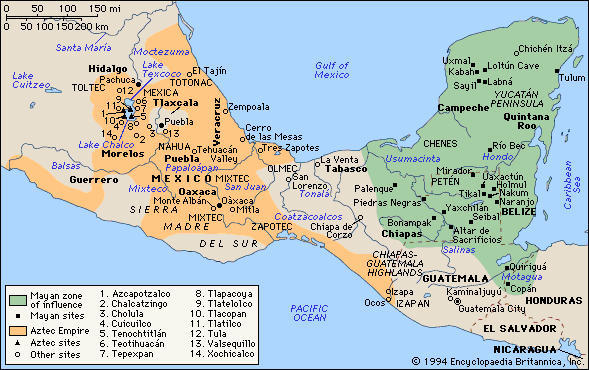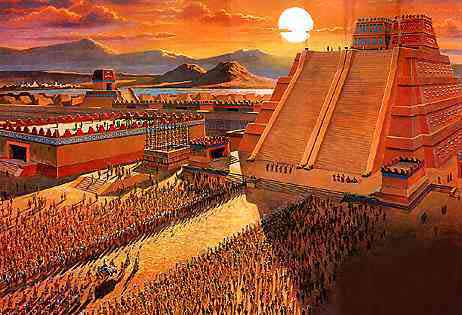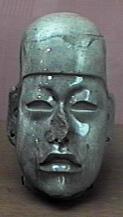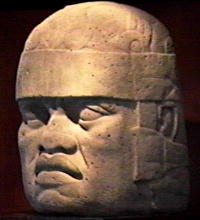
Statue found by archaeologists in an ancient Olmec (1600BC) site.
Posted on 11/12/2003 10:08:07 AM PST by blam
Ancient Bones Found in Honduras Said to Be Olmec
TEGUCIGALPA, Honduras (Reuters) - Human bones believed to date from the ancient Olmec civilization have been found in southeastern Honduras, suggesting the influential culture extended farther than previously thought, Honduran authorities said on Tuesday.
Missed Tech Tuesday? Here's the real reasons you need speed, plus better broadband tips and making do with dial-up.
Carmen Fajardo, at the Honduran Institute of Anthropology and History, said it appeared to be the first time Olmec remains have been found outside the so-called Mesoamerican corridor that stretches from Mexico to central Honduras.
"For the first time various bones have been found in Honduras with a deformity to the skull ... characteristic of the Olmec culture which considered this a sign of beauty," Fajardo told Reuters.
Olmec culture originated in Mexico and extended to Belize, Guatemala, El Salvador (news - web sites) and parts of Honduras. Many cultural and religious elements of ancient civilizations including the Aztecs and Mayans have Olmec roots.
Olmec pottery has been discovered in northern Honduras dating back to 1600 B.C. within the Mesoamerican zone but not human remains, Fajardo said.
Four skulls, various bones and 10 plates dating back to 1500 B.C. were found on a mountain called Cerro de las Cuevas de las Campanas, 90 miles east of the capital Tegucigalpa, near the border with Nicaragua.
"These remains ... were found outside the Mesoamerican zone where the Olmec culture, known as the mother culture of Mesoamerica, exerted its influence," Fajardo said.
Southeastern Honduras, Nicaragua, Costa Rica and Panama are considered part of an intermediate area influenced by the culture of the Andes.
"Our conclusions so far are preliminary ... but we still have to do carbon and DNA tests," she said.
"It could be that there is a third cultural area we haven't identified where the Mesoamerican area and intermediate meet," said Fajardo.

Statue found by archaeologists in an ancient Olmec (1600BC) site.
Let me know if you wish to be added or removed from this ping list.
For real time political chat - Radio Free Republic chat room




Olmec Donald had a farm.
19:00 05 December 02
NewScientist.com news service
The discovery of a fist-sized ceramic cylinder and fragments of engraved plaques has pushed back the earliest evidence of writing in the Americas by at least 350 years to 650 BC.
Rolling the cylinder printed symbols indicating allegiance to a king - a striking difference from the Old World, where the oldest known writing was used for keeping records by the first accountants.
http://www.newscientist.com/data/images/ns/9999/99993151F1.JPG (Photo: Teresa Carmona. Drawing: Ayax Moreno)
Archaeologists uncovered the cylinder and fingernail-sized fragments among debris from an ancient festival at San Andres, an Olmec town on the coastal plain of the Mexican state of Tabasco.
Carbon dating of layers in the rubbish heap gave age of the artefacts. The next-oldest writing from the region is on a monument at a site of the Zapotec culture 300 kilometres to the west. But its date is poorly constrained, to sometime between 300 BC and 200 AD. Three later cultures in the same area used similar writing, the well-known Mayan, and the lesser-known Isthmain and Oxacan.
The cylinder shows two glyphs linked by lines to the mouth of a bird, giving the impression the glyphs are being spoken. One is "ajaw," meaning "king," and the other "three ajaw", a day in the sacred 260-day calendar used throughout the region for over a millennium.
Body paint
Later cultures used similar lines to show speech by people as well as by animals. When covered with ink or paint, the roller printed the bird and symbols on cloth or people's bodies. The date probably was the king's name, a common practice at the time.
"It's a kind of royal seal, used in decoration," Mary Pohl, an anthropologist at Florida State University in Tallahassee, told New Scientist. People in San Andres probably wore it "to show their fealty to the king" who resided at the main Olmec city of La Venta nearby.
The Olmec were the first American culture with a distinct ruling class, and Pohl believes they developed writing for rituals and rulers. Later Mesoamerican writing retained the links to kings and rituals, including the sacred calendar. Pohl says that writing could have originated at the start of the first Olmec culture in 1300 BC, but no evidence has survived.
In contrast, Old World writing is far older and traces back to tokens placed in clay envelopes to keep account of animals or other possessions. By about 3000 BC, symbols written on tablets replaced the tokens, becoming the world's first writing.
Journal reference: Science (vol 298, p 1984)
Jeff Hecht
I'm giving you a 9.7 on that one.
We saw the Olmec heads when we were in Villahermosa. If I remember correctly, they were found when they drained the swamps at LaVenta.

Olmec Donald

What did this 'deformity' look like?

Disclaimer: Opinions posted on Free Republic are those of the individual posters and do not necessarily represent the opinion of Free Republic or its management. All materials posted herein are protected by copyright law and the exemption for fair use of copyrighted works.